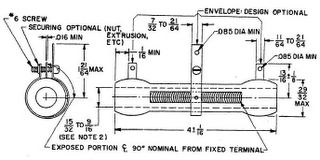Tuesday, January 26, 2010
How to increase page content and grow visitors
Now over time more and more content was slowly added as a new definition was added or a resistor definition was expanded. Also related content was added, as in 'Trimmer Packages', but was included in a different section of the site which is not represented as being part of the Resistor Dictionary. As a few of the pages grow to large they were subdivided into two pages growing the size in pages of the dictionary. For example back in June of 2009 [blog; Terms used with Resistors], the page "F-M' was separated into two pages increasing the size of the dictionary from 10 to 14 pages.
Now to the point; look how long it takes even to get a small amount of page views. It took 8 months before the page views consistently lifted off the zero floor. Another 6 months after that before the pageviews doubled. So, over a year before the section started to get a decent amount of page views. Still 6 months after that and the pageviews are just stable, or maybe increasing just a tad.
As always my SEO advice is start a page topic as soon as possible. Now if the page has little or no content don't blog about it. Just add it to your site-map or let the search engine find it over the upcoming month.
The bad side of this increase [which is only a few dozen pageviews] is that over the same time frame, other pages are declining in page views. For example the Unified Display Interface has been declining ever sense the page was added three years ago. Now that standard was started but never supported so it's not the fault of the web page. The issue leaves the entire web site with near flat pageviews, as some pages are increasing while other have to see a decrease in pageviews.
Posted by
Leroy
at
10:23 AM
0
comments
![]()
Labels: Dictionary, Resistors, Stats
Monday, January 12, 2009
Resistor Manufacturers

As part of interfacebus, I've had a page covering Manufacturers of Resistors on the web for about ten years now. The page covering Resistors is well established after 10 years on the internet
The Resistor vendors page grows in size or reduces as links are added or removed. The other day four 'redundant' manufacturers were removed from the listing as they all pointed to the company that acquired them. Normally I'll leave a reference to a company that was purchased so people can still find the new company, but after awhile the old link gets removed.
From the "What's New blog" I see a new page dealing with Current Sense Resistors was added in April 2008. Adding a related page to resistors means removing all references to Current Sense Resistors from the main Resistor listing, so that they only show up on the new page, other wise both pages would appear to cover the same topic. Of course removing any information relating to current sense resistors reduces the amount of text from on the main resistor page.
April 2008 also saw a number of new pages that related to Resistors but did not require information being drained off the main resistor page. The new pages provided more incoming links [external pages linking to] the Resistor Manufacturers page. Incoming links should help a page gain visits by providing additional ways to find a page topic. How ever at the same time similar topics on the same web site could end up dividing the traffic between all related topics.
The point is I see a reduction in visits to the Resistor Manufacturers page over the last few years. Page views in 2006 seemed flat, but appeared to start decreasing from 2007 on. Page visits look stable from July 2008 on but are down 60 percent.
Posted by
Leroy
at
6:14 PM
0
comments
![]()
Labels: Manufacturers, New Pages, Resistors, Vendors
Sunday, March 26, 2006
WireWound Resistor

WireWound Resistor
The chart below depicts the temperature dereating for an Adjustable WireWound resistor. A Wirewound resistor is used in high power applications. The type of Wire wound resistor shown in the picture above is adjustable, but requires a screw driver to move the tape. This link provides Potentiometer Manufacturers

WireWound Derating Curve
Also refer to the Resistor Dictionary of Terms.
How to derate an Adjustable WireWound Resistor.
Additional information may be found on the Guideline for Derating Electronic Components
Home Page
Posted by
Leroy
at
1:32 PM
1 comments
![]()
Labels: Resistors

